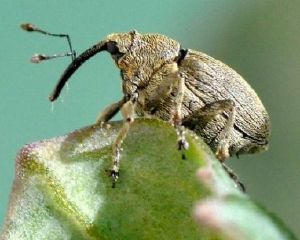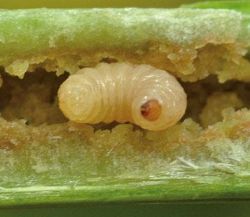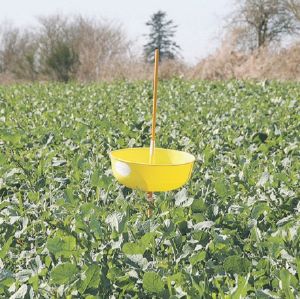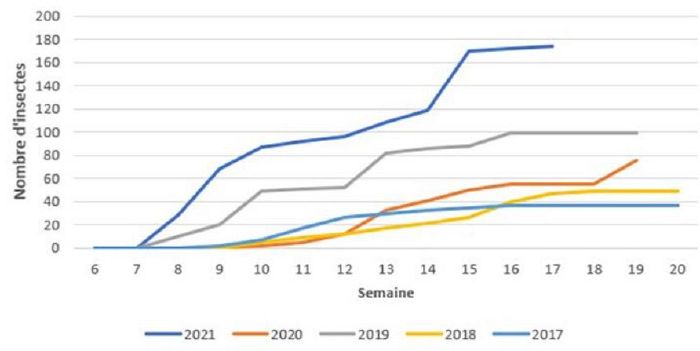Rape Stem Weevil

The rapeseed stem weevil (Ceutorhynchus napi) causes stem bursts that are very damaging to the crop. For this pest, trapping in the field will give an alert, but network risk analysis is preferable to simple observation in isolated plots. Generally speaking, egg-laying makes plants more sensitive to subsequent stress and limits their ability to compensate. Hydric stress on an oilseed rape previously weakened by stem weevil is therefore more damaging.
Description

Adult
- Ash-grey in colour.
- Black leg tips.
- Size 3 to 4 mm.
Larva
- Whitish body, black to light brown head, no visible legs.
- Maximum size 7 to 8 mm.
Not to be confused with the cabbage stem weevil, which is light grey with reddish legs and is harmless.
Symptoms in oilseed rape
The damage caused by rapeseed stem weevil is linked to egg-laying, which triggers a reaction in the plant tissues.
The symptoms that can be observed are :
- Swelling and deformation of the stems.
- Longitudinalsplitting of the stem.
- Severely affected plantsdie back.
Yield losses are particularly severe in dry conditions.
Period of presence
Depending on weather conditions, flight can be early (mid-February) or late (during March).
Période de présence :
| J | F | M | A | M | J | J | A | S | O | N | D |
Observation methods
Setting up a network of traps and correctly identifying the insects caught are the best indicators of the risk to the crop.
When to monitor
Attention : Monitoring is only usefulbetween the C1 stage (appearance of the first internodes, if there was no elongation in the autumn) and the E stage (buds separated, flower stalks lengthening). From the C2 stage onwards (visible internodes and appearance of tender stems), the eggs laid by the weevil in the stems cause all the more visible damage (broken or deformed stems) if the eggs are laid in a rapidly growing stem.
The yellow cuvette

- The tray should be set up as soon as vegetation starts, 10 metres from the edge of the plant and in the sun, to represent the maximum risk.
- Every week, the tray should be lifted onto its stem so that it is always slightly above the rapeseed.
- Put a littlewater in the tray with a wetting agent (washing-up liquid) so that the insects don't stick out. This water is changed regularly.
- Every week, the number of insects in the bowl is determined and counted.
It is essential to set them up before the insects arrive in the plots, so as to be able to detect pest flights. Stem weevil activity resumes when temperatures are mild, around 9-10°C. From 12°C onwards, flight becomes more widespread. Identifying the date of arrival is vital in deciding when to take action.
For this pest, trapping in the field will give an alert, butnetwork risk analysis is preferable to simple observation in isolated plots.
Intervention
The state of the crop, its stage and stem height or the number of catches in a yellow vat are not sufficient to decide whether to take action or not to take insecticide action at plot level.
On the other hand, a look back at the last few campaigns shows that years with early and massive flights are the years in which the most damage (frequency and intensity) is seen in plots across a territory (2019 and 2021 in the diagram below).[1]. These years are also often characterised by a second flight peak at the end of March - beginning of April :

Take action at peak flight
Thereis no rush to take action when the first traps are caught, as the females are not ready to lay eggs when they arrive in the plots. It takes between 7 and 10 days before the first eggs are laid. There is no point in spraying when the first females are caught, as the risk is greatest when the majority of individuals are present in the plot.
To ensure safe production, you should therefore spray 7 to 10 days after the first "significant" captures (around 4-5 insects minimum) or ideally at the regional flight peak (consult your region's Bulletin de Santé du Végétal to find out the date of the flight peak for your region). Theaim is tospray when as many insects as possible are in the plot and before they start laying eggs.
If you spray too early, you run the risk of not covering the risk of later arrivals. So it's better to wait a few days, even if it's true that the organisation of work (sowing, nitrogen, etc.) and weather conditions can complicate implementation at this time of year. Of course, if very heavy trapping has been observed for more than 5 days and if the weather forecast is not good (heavy rain preventing intervention), it may be appropriate not to wait.
Late infestations or re-infestations should not be overlooked.
If no significant captures are recorded, check that the vial is correctly positioned and continue monitoring the plot. At the same time, it is important to keep abreast of the situation in neighbouring plots and to follow the progress of captures in the monitoring network via the BSV.
No more "20 cm stem" threshold : stem bursts can occur under flower clusters up to the bud stage (D2 - E). Generally speaking, a single well-timed application is enough to control most of the risk. However, if a second flight peak occurs 2-3 weeks after application, a further application may be considered.
In 2021, the spread of the flight (February to April) with a second peak at the end of March/beginning of April made it difficult to position insecticide applications and explains the symptoms of deformed stems and the presence of larvae in the stems. Coverage in early March was not sufficient to cover the risk period.
Pressure level
If the presence of stem weevil is confirmed around the plot, regular monitoring should be stepped up.
- Low : Observation of one individual in the yellow cuvette.
- Medium : More than one individual observed in the yellow vat.
- High : More than one individual observed in the yellow vat and the first eggs laid, when the maximum daily air temperature exceeds 9-10°C.
Pressure levels are given for information only and do not reflect the exact severity of infestation at any given time or subsequent damage. Other factors specific to the crop and the dynamics of the development of symptoms or infestations are also involved.
Insecticide solutions
When spraying, beware of bees. Oilseed rape is a melliferous plant much visited by pollinating insects ! If phytosanitary treatment is planned, the rules laid down in the regulations must be complied with. Carrying out the treatment late in the evening will give the plant all night to absorb the product.
- DECIS PROTECH 0.33 l/ha and KARATE ZEON 0.075 l/ha are effective in reducing rapeseed stem weevil damage (reduction in the number of deformed and/or broken stems).
- TREBON 30 EC is comparable to the references. BORAVI WG, SHERPA 100 EW and CYTHRINE MAX are slightly behind.
Warning : TREBON 30 EC or MAVRIK SMART should be reserved for possible control of meligèthes between stages D1 and E-F1. Note that if there is a simultaneous risk of meligethes and stem weevils, TREBON 30 EC should be used to control both targets at the same time.
Agronomic levers
The aim is to produce a robust oilseed rape that is more resilient to weevil attacks. To achieve this, a number of agronomic levers can be used :
- Staggering the sowing date.
- Companion plants.
- Achieving key states.
- Choice of variety.
- Non-stop dynamic growth of oilseed rape during the autumn, which requires careful management of nitrogen fertilisation.
Other levers are being studied, such as sheep grazing.
Assessing the amount of nitrogen in the soil
The amount of nitrogen absorbed in the autumn varies greatly from one situation to another, and so needs to be assessed : weighing the biomass at the end of winter is essential. After that, the amount of nitrogen to be applied will depend on the condition of the rapeseed and the total amount to be applied.
Practical information :
- Take and weigh the above-ground biomass of rapeseed over 1 m² if sown with a cereal drill, or the equivalent if sown with a single-seed drill (1.67 linear metres for a 60 cm spacing or 1.25 linear metres for an 80 cm spacing).
- Once the weighings have been carried out, the values must be entered into the Réglette Azote colza® tool, along with the yield target (Olympic average over the last 5 years).
- The tool then calculates the nitrogen dose to be applied to the plot.
Results [2]:
- For "small colza" crops (biomass < 1kg), which have stored little nitrogen before vegetation resumes, it is recommended to apply an initial dose (no more than 50 units) as soon as the new leaves emerge, when vegetation resumes.
- Large oilseed rape crops (biomass > 1.5 kg), showing no signs of nitrogen starvation, have stored enough nitrogen to ensure vegetative recovery and even the start of bolting, i.e. stem production, for the largest.
- For oilseed rape with a biomass of between 1 kg/m² and 1.5 kg/m², the first application should be made according to the condition of the oilseed rape, in particular by spotting any signs of nitrogen starvation (reddening).
This article was written in partnership with <a href="https://www.agrifind.fr/">Agrifind</a> and <a href="https://www.terresinovia.fr/">Terres Inovia</a>.
Sources
- Conduct in relation to the rapeseed stem weevil - Terres Inovia.
- Resumption of vegetation and arrival of the rapeseed stem weevil in the South-West - Terres Inovia.
- Control of rapeseed stem weevil : positioning is crucial - Terres Inovia.
- Withdrawal of Phosmet : the industry is mobilised to propose solutions for the short and medium term - Terres Inovia.
- Winter oilseed rape : keep an eye on spring pests - Terra.
- ↑ Autore Baillet, Lutte contre le charançon de la tige du colza : le positionnement est déterminant, Terres Inovia, https://www.terresinovia.fr/-/lutte-contre-le-charancon-de-la-tige-du-colza-le-positionnement-est-determinant?utm_source=NEWSLETTER&utm_medium=EMAIL&utm_campaign=ZONE_NE&utm_term=COLZA
- ↑ Terres inovia Sud-Ouest, Reprise de végétation et arrivée du charançon de la tige du colza dans le Sud-Ouest, https://www.terresinovia.fr/-/reprise-de-vegetation-et-arrivee-du-charancon-de-la-tige-du-colza-dans-le-sud-ouest?utm_source=NEWSLETTER&utm_medium=EMAIL&utm_campaign=ZONE_SUD_Tournesol_webserie1_Colza_chartige_lentille_20200211&utm_content=COLZA
Annexes
S'attaque aux cultures

